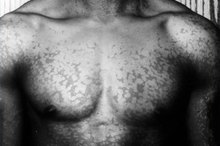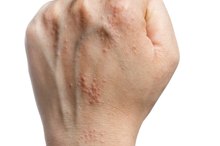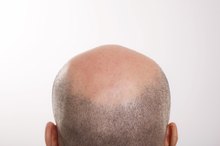Stages of Tinea Versicolor
Dormancy
Tinea versicolor is also known as haole rot 1. It is a skin infection that occurs in an estimated 8 percent of the population. It is caused by the yeast Malassezia globosa. This yeast lives on the skin of human beings and animals under normal conditions and is kept in check by the body's cells and immune system.
If you are experiencing serious medical symptoms, seek emergency treatment immediately.
- Tinea versicolor is also known as haole rot 1.
- This yeast lives on the skin of human beings and animals under normal conditions and is kept in check by the body's cells and immune system.
Overgrowth
Skin Fungus That Causes White Spots
Learn More
The yeast only becomes an issue under certain conditions. A hot, wet, humid environment encourages their growth, meaning those who live in tropical and sub-tropical climates are at greater risk for tinea versicolor, as are those who don't bath regularly 1. Even then, the yeast cannot infect the body unless the body's immune system is compromised in some way. If an individual were suffering from AIDS, frequent inflammatory problems, leukemia or other disease that decreased the number and effectiveness of the body's white blood cells, only then would the yeast grow unstopped to such numbers as to cause a secondary infection.
- The yeast only becomes an issue under certain conditions.
- Even then, the yeast cannot infect the body unless the body's immune system is compromised in some way.
Reaction
Tinea versicolor is characterized by a profusion of irregular or oval-shaped spots roughly one-quarter inch in diameter across the chest or back 1. They are usually pink or reddish-brown in color and not raised from the skin. Itching generally occurs only when the skin becomes dry or overheated, while sweat and warm water can sooth the sensation. All these symptoms are the body's reaction against the final stage of tinea versicolor infection 1. The skin becomes red because the immune system is sending platelets to the affected areas in order to stem the spread of the infection; this creates the pigmentation. The itch is caused by the yeast eating away at the infected skin cells. Shortly after the initial appearance of the spots, the skin becomes flaky and sloughs away, which is the body's attempt to counter the infection by growing new skin cells and destroying the infected ones. At this stage, tinea versicolor either clears up within a few weeks or is helped along with anti-fungal ointment 1.
Related Articles
References
- Tinea Versicolor Causes
- Harada K, Saito M, Sugita T, Tsuboi R. Malassezia species and their associated skin diseases. J Dermatol. 2015 Mar;42(3):250-7. doi:10.1111/1346-8138.12700
- Gupta AK, Foley KA. Antifungal treatment for pityriasis versicolor. J Fungi (Basel). 2015 Mar 12;1(1):13-29. doi:10.3390/jof1010013
- Hudson A, Sturgeon A, Peiris A. Tinea versicolor. JAMA. 2018 Oct 2;320(13):1396. doi:10.1001/jama.2018.12429
- Karray M, McKinney WP. Tinea (Pityriasis) Versicolor. In: StatPearls [Internet]. Treasure Island (FL): StatPearls Publishing; 2019 Jan-. Updated April 1, 2019.
- Kaushik N, Pujalte GG, Reese ST. Superficial fungal infections. Prim Care. 2015 Dec;42(4):501-16. doi:10.1016/j.pop.2015.08.004
- Renati S, Cukras A, Bigby M. Pityriasis versicolor. BMJ. 2015 Apr 7;350:h1394. doi:10.1136/bmj.h1394
Writer Bio
John Albers has been a freelance writer since 2007. He's successfully published articles in the "American Psychological Association Journal" and online at Garden Guides, Title Goes Here, Mindflights Magazine and many others. He's currently expanding into creative writing and quickly gaining ground. John holds dual Bachelor of Arts degrees from the University of Central Florida in English literature and psychology.









